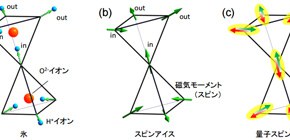
Realization of quantum spin liquid state due to crystal’s structural disorder
Will lead to application to next-generation devices of spintronics and quantum computers
A group of researchers from The University of Tokyo, together with Osaka University, Stanford University (U.S.), Johns Hopkins University (U.S.), and the National Institute of Standards and Technology (U.S.), conducted neutron scattering experiments and model analysis of Pr 2 Zr 2 O 7 quantum spin ice with the pyrochlore lattice and found that, against conventionally accepted ideas, a quantum spin liquid (QSL) state might be stabilized by quantum fluctuations enhanced by structural disorder.
Normal magnetic matter becomes a solid state in which spins come to rest in a particular orientation as temperatures are cooled down to absolute zero. However, in recent years, a QSL state, a state that preserves its disorder to very low temperatures, is theoretically predicted, drawing attention.
It is thought that the QSL state could appear in spin ice, or a frustrated Ising model on the pyrochlore lattice, in which spins freeze with macroscopically visible degeneracy. Researchers have been studying all over the world in order to verify a theoretical proposal that the QSL state can be realized by enhancing quantum fluctuations and melting the state of ice. Although some candidate materials of QSL were found, the mechanism behind QSL-like behavior was unknown.
This group had found that spins didn’t freeze in spin ice material Pr 2 Zr 2 O 7 at the lowest temperature because of strong quantum fluctuations and behaved like QSL. In this study, the group explored the cause of strong quantum fluctuations and experimentally found the possibility that the QSL state might be stabilized due to crystal’s structural disorder in spin ice material Pr 2 Zr 2 O 7.
Conventional studies advocated that structural disorder caused spin freezing and interfered with the formation of QSL. This group’s achievements raised a question about that theory and it is expected the study results will provide new guidelines to the development of magnetic materials in which QSLs occur. The clarification of differences between the QSL due to structural disorder that this group discovered and the QSL that is expected of pure materials (in the future) is very important in understanding the whole picture of QSL.
Recent studies clarified that controlling the Pr (pyrochlore)/Zr (zirconium) ratio can extensively control the structural disorder in pyrochlore lattice. The measurement of properties of matters by using samples synthesized with less structural disorder by precisely controlling the combination ratio will drastically promote the understanding of QSL. This will lead to application to next-generation devices of spintronics and quantum computers that use QSL entanglement in the future.
Abstract
Inelastic neutron scattering reveals a broad continuum of excitations in Pr 2 Zr 2 O 7 , the temperature and magnetic field dependence of which indicate a continuous distribution of quenched transverse fields ( Δ ) acting on the non-Kramers Pr 3 + crystal field ground state doublets. Spin-ice correlations are apparent within 0.2 meV of the Zeeman energy. A random phase approximation provides an excellent account of the data with a transverse field distribution ρ ( Δ ) ∝ ( Δ 2 + Γ 2 ) − 1 , where Γ = 0.27 ( 1 ) meV . Established during high temperature synthesis due to an underlying structural instability, it appears disorder in Pr 2 Zr 2 O 7 actually induces a quantum spin liquid.
Figure 1
Figure 2
Figure 3
To learn more about this research, please view the full research report entitled " Disordered Route to the Coulomb Quantum Spin Liquid: Random Transverse Fields on Spin Ice Pr 2 Zr 2 O 7 " at this page of the Physical Review Letters website.
Related link

